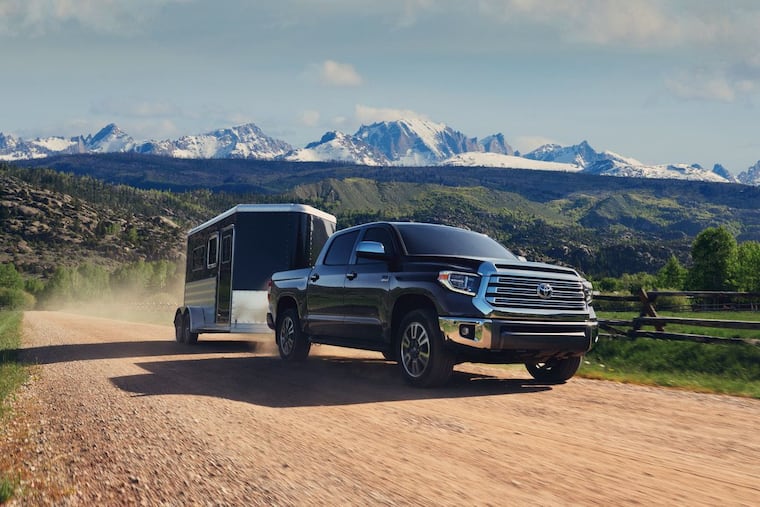2021 Toyota Tundra finally adds some agility to its speed, hauling, and towing performance
The 2021 Toyota Tundra does not differ much from the 2020 — or from the 2018, or even the 2012, for that matter. But it has gotten easier to drive. It's a strong, quick truck, although hungry.

2021 Toyota Tundra 4x4 1794 Edition CrewMax: No new tale to tell?
Price: $55,199 as tested. TRD Off-Road Package added 18-inch wheels, Bilstein shock absorbers, and some cool off-road effects for $155; sunroof, $850; bed liner, $579. More below.
Marketer’s pitch: Nothing too catchy on the website.
Conventional wisdom: Consumer Reports likes the “powerful 5.7-liter engine, high tow ratings, standard advanced safety equipment,” but not that it “lacks the refinement and ride comfort of the more modern competition, limited array of build configurations, compared to the domestics, and fuel economy.”
Reality: Still big and powerful, but getting easier to handle.
What’s new: I think the lack of a marketer’s pitch speaks volumes: Trucks sell themselves. The Tundra has not gotten a redesign since 2014, and even that was a mild one. It’s not much different from the truck introduced in 2007. Automakers love that buyers pay all this money for trucks; so much profit, so little investment.
A redesign — talked about for years now — looks to be on the horizon for the 2022 model year.
» READ MORE: 2018 Toyota Tundra: A fresh look with a ride ’em cowboy ride
Just hauler: Still, I’m pleased for the chance to test the trucks when they come along.
I used it for clearing the yard of branches and carrying a ladder, and found it hauled quite a bit, with eight easy-access tie-down hooks and a step bumper. The running boards ($345) didn’t extend far enough to help much with loading.
The Tundra moves 1,730 pounds of stuff and 10,200 pounds of trailer in two-wheel-drive form, while CrewMax owners must settle for 1,560 and 9,800, respectively.
Up to speed: The 5.7-liter V8 definitely moves the Tundra willingly. Its 381 horsepower motivates the big truck to 60 mph in 6.4 seconds, according to a Car and Driver test of a 2017 model.
On the road: Sturgis Kid 4.0 called the 2018 incarnation of the Tundra “the bounciest truck.” But you can see where he gets it. The old man called the 2012 version “floppy.”
I’m happy to report the floppery and bounciness both seem to be eliminated from the 2020 version of the Tundra tested. It’s still a big boy and a whole lot to handle, but at least now I don’t feel as if I’m listing from side to side. I can live with the Tundra now.
Perhaps credit the TRD Off-Road Package with this taming of the beast.
Burp: I can live with driving the Tundra, but refueling is another matter. I took the Tundra out on a mix of highways and back roads and the fuel consumption never reached 12 mpg. Eeek. I think I miss the old 4.6-liter (which left the Tundra after 2019).
But, on the savings side, you can feed the Tundra whatever.
Shifty: The six-speed automatic is like a page out of history, so that’s not helping the economy either. It doesn’t really offer shiftability; like most Toyotas, it just offers gear selection and limiting. But it works fine.
Driver’s Seat: Roomy and comfortable, the 1794 Edition means that the truck sports some striking brown leather interior. Gauges and functions are easy to spot and reach, although my foot angle at the pedals felt as if it could become painful over the long haul.
Room for friends: When Toyota says CrewMax, they mean it. The space in the backseat is cavernous — plenty of headroom, legroom, and foot room for stretching in all directions. The seat, though, is a bouncy, sad replica of the awesome, roomy front seats. It also leans too far back without any adjustments available.
The seat does fold up 60-40 to create a large cargo bay, though.
Play some tunes: The stereo operates efficiently and easily, with big dials for volume and tuning, buttons for sourcing, and a simple touchscreen for the rest.
Toyota is finally catching on to quality stereo sound. The premium JBL 12-speaker system offers clear reproduction and plenty of range — not all tinny like Toyotas often are. Call it an A-.
Keeping warm and cool: The round vents look pretty neat and are easy to direct and close as needed. Dials control temperature and fan speed while buttons control sourcing.
(Fuel consumption: It’s above, for those of you who skip to here every week.)
Where it’s built: San Antonio.
How it’s built: The Tundra gets a 4 out of 5 for reliability from Consumer Reports.
In the end: That fuel economy is pretty dismal. Hopefully Toyota is thinking of a hybrid for next year. Otherwise, the Tundra has evolved into a nice companion.